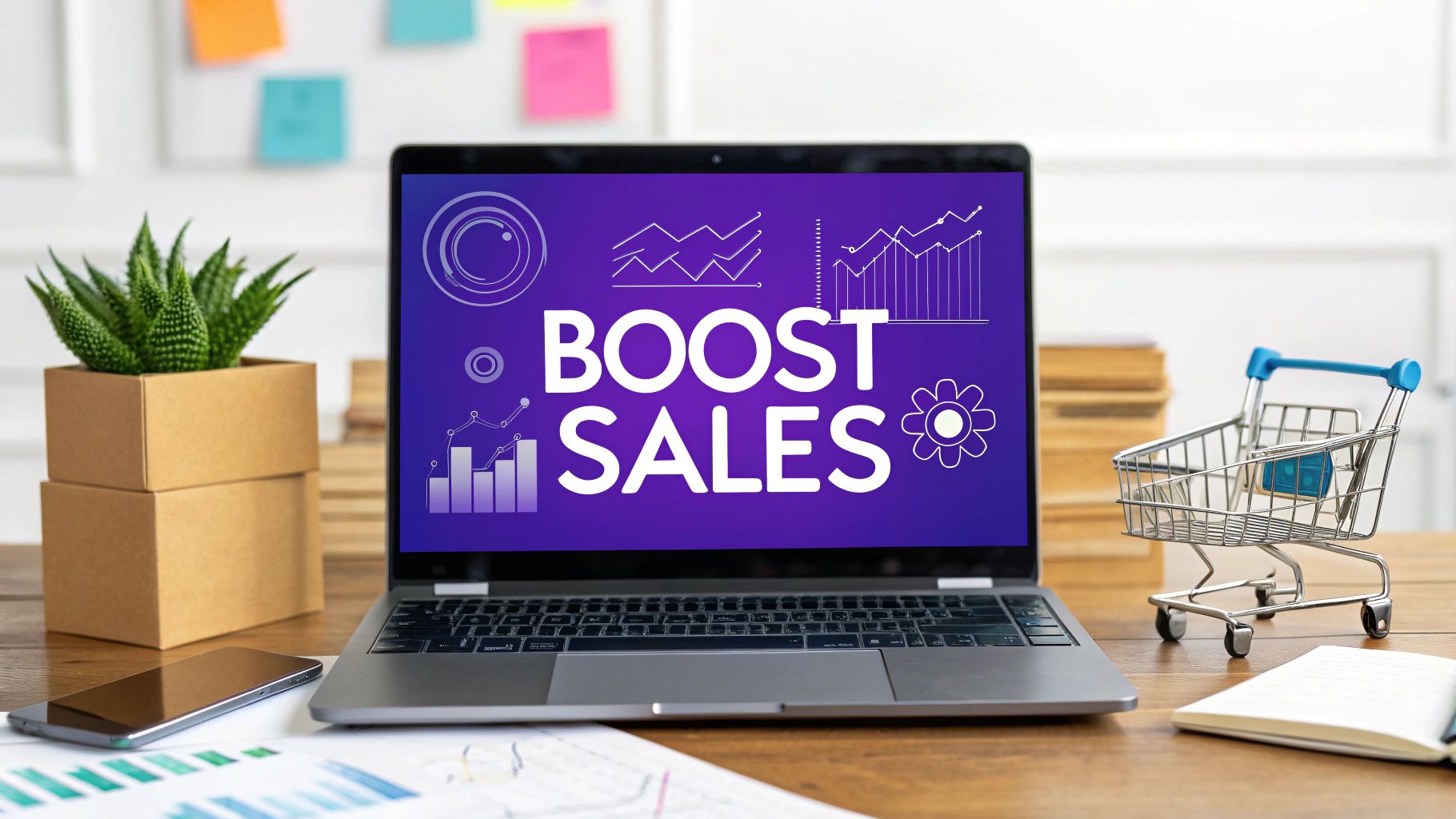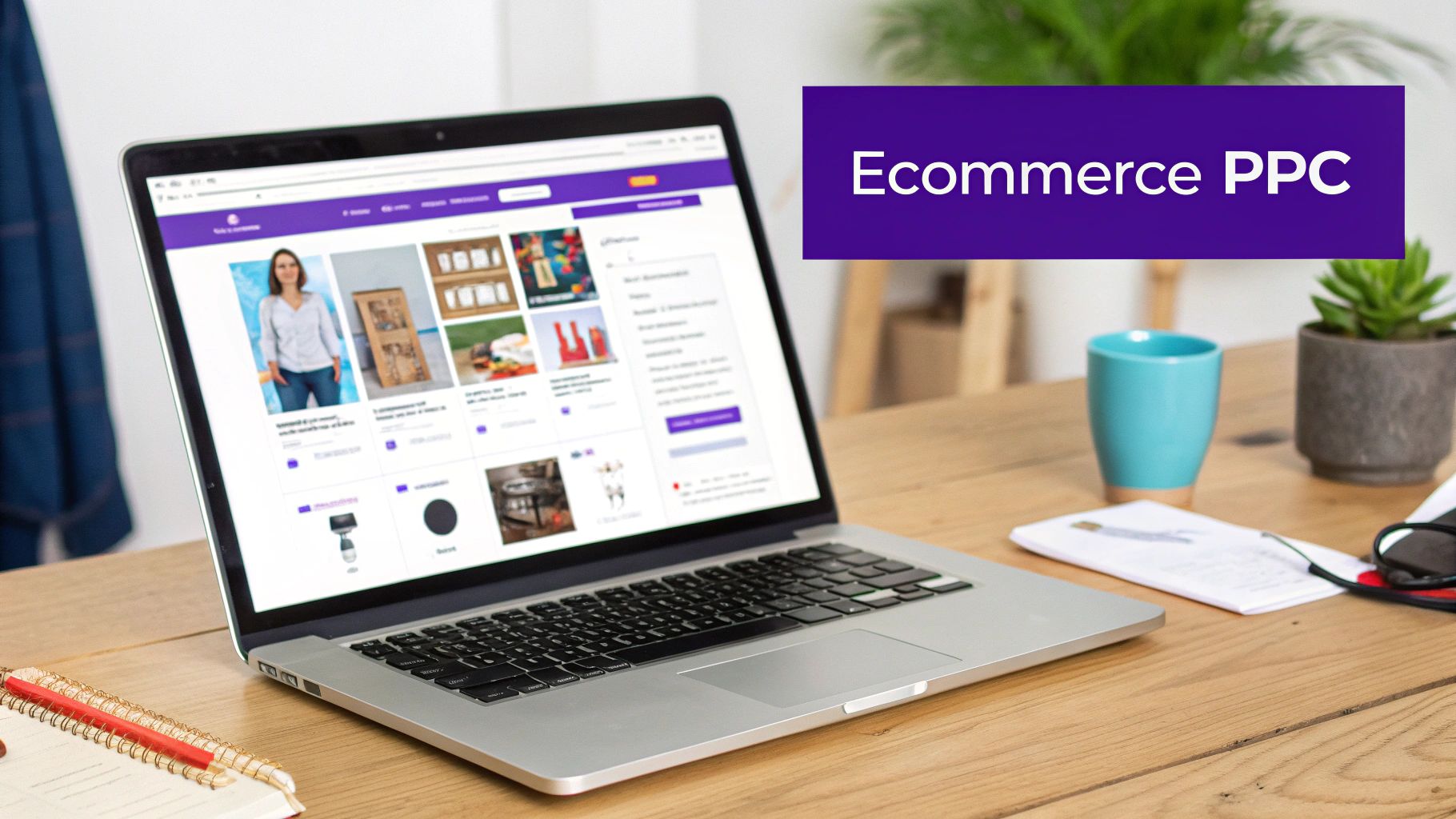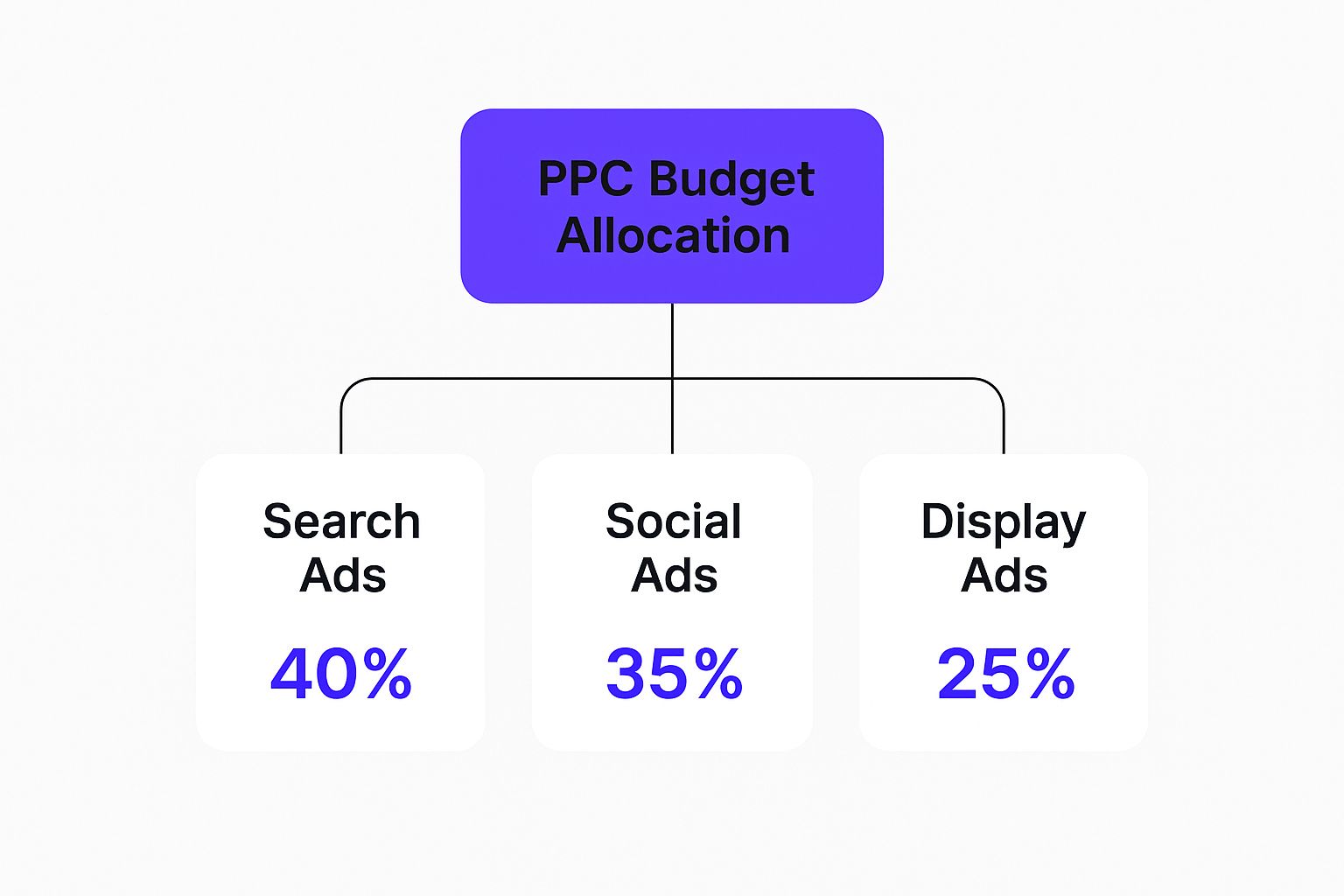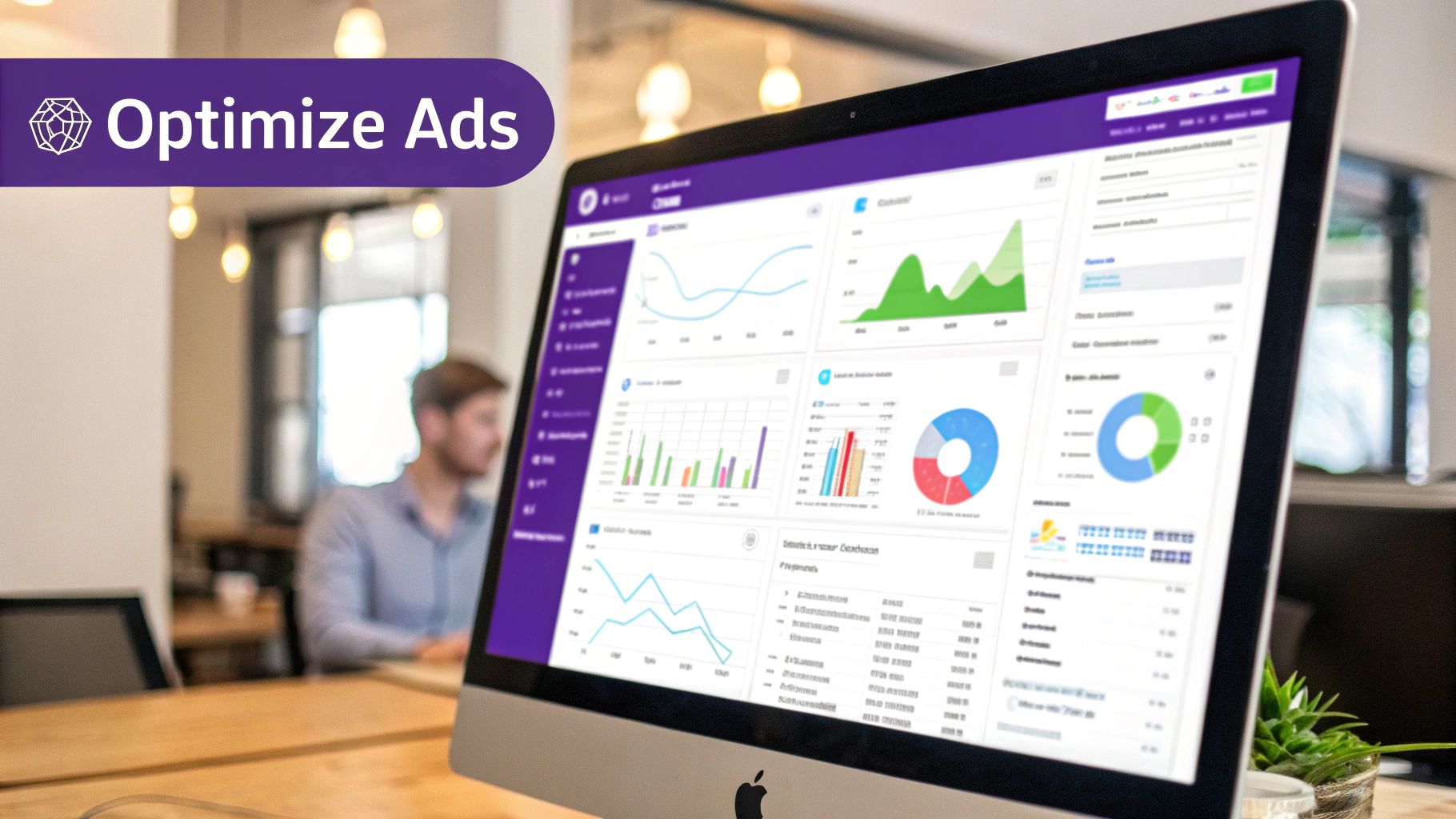Ecommerce PPC Marketing: Boost Sales with Proven Strategies

Ever wonder how some online stores seem to pop up everywhere you look? Chances are, they're using Pay-Per-Click (PPC) marketing. In a nutshell, ecommerce PPC is all about paying to place your products directly in front of customers who are ready to buy.
Instead of crossing your fingers and hoping shoppers stumble upon your store organically, you bid for prime advertising real estate on platforms like Google or Facebook. This ensures your products get seen first, right when it matters most.
What Is Ecommerce PPC and Why It Matters

Think of the internet like a giant, sprawling supermarket. Search Engine Optimization (SEO) is like carefully arranging your products on the shelf, hoping a curious shopper wanders down your aisle. Ecommerce PPC marketing, however, is like buying that impossible-to-miss promotional display right at the front entrance.
You're not just buying random clicks. You're making a strategic investment in immediate visibility, capturing a potential customer's attention the very moment they show they're interested. This direct line to buyers is what makes PPC an essential tool for any online store serious about growing fast.
PPC vs Organic Traffic Key Differences for Ecommerce
To really grasp why PPC is so powerful, it helps to see how it stacks up against organic traffic from SEO. They both aim to bring people to your site, but they go about it in completely different ways.
Both have their place in a healthy marketing mix, but PPC gives you the speed and control that organic methods simply can't match.
The Core Benefits of PPC for Online Stores
The biggest win with a smart ecommerce PPC strategy is the speed. Unlike organic marketing that takes months to gain traction, a PPC campaign can start funneling highly motivated shoppers to your product pages the same day you launch it.
This speed comes with incredible control and transparency. You can track every single dollar, giving you crystal-clear data on what’s working and what’s not. This lets you tweak your campaigns on the fly and scale up your winners without any guesswork.
The real magic of PPC is its precision. You can connect with your ideal customer, put a specific product in front of them, and do it at the exact moment they're pulling out their wallet.
Why PPC is a Growth Engine
Pay-per-click advertising has become a non-negotiable for modern commerce, with a massive 80% of businesses using it to drive growth. A big reason for this is its sheer effectiveness; PPC traffic can convert 50% better than organic traffic because it targets users with clear buying intent.
This strategic approach lets you:
- Target High-Intent Shoppers: Get in front of people actively searching for exactly what you sell.
- Gain Immediate Traffic: Skip the long wait for SEO and get visitors to your site now.
- Receive Clear Performance Data: Instantly see your Return on Ad Spend (ROAS) and make smart, data-backed decisions.
For online stores, especially those in crowded markets, mastering paid ads is often the difference between blending in and breaking out. If you sell on major marketplaces, diving into platform-specific strategies is crucial. For instance, a comprehensive guide to Amazon PPC marketing can show you the ropes for that particular ecosystem.
Ultimately, PPC gives you the power to turn your advertising budget into a predictable, profitable sales machine.
Choosing the Right Ad Platforms for Your Store
Deciding where to spend your ad budget isn't about finding the one "best" platform. It’s more like picking the right tool for the job. Each platform has a totally different vibe and attracts people in a different frame of mind, and getting that difference is the key to a smart ecommerce PPC strategy.
So, where are your customers hanging out online? And, more importantly, why are they there? Nailing this down will help you choose between the two heavyweights in the ad world: Google Ads and Meta Ads (which covers Facebook and Instagram).
Capturing Active Shoppers with Google Ads
Think of Google as the world's biggest, most organized hardware store. When people go there, they usually have a problem and are actively looking for a solution. They're on a mission. They type in things like "buy waterproof hiking boots size 10" or "best organic dark roast coffee beans."
This is what we in the biz call search intent. Your potential customer already knows they have a need and is hunting for the right product to fill it.
Key Takeaway: Google Ads is your absolute best bet for capturing existing demand. You’re basically putting your products right in front of people who are already halfway to buying. The job isn’t to convince them they need something; it's to show them you’ve got exactly what they’re looking for.
For ecommerce stores, Google Shopping ads are an absolute goldmine. They're the super visual listings that pop up with your product image, price, and store name right in the search results. This makes it ridiculously easy for a motivated buyer to see what you've got, click, and head straight to your checkout.
Creating New Buyers with Meta Ads
Now, if Google is the hardware store, then Meta (Facebook and Instagram) is more like a bustling town square or a weekend market. People aren't there with a shopping list in hand. They're catching up with friends, scrolling through their hobbies, and just discovering cool new stuff.
This is where you get to create demand, not just fulfill it. Your ads slide right into their social feeds, catching their eye with a product they never knew they needed until that very moment. Picture a stunning video of a self-watering planter popping up in a plant lover's feed—they weren't looking for it, but now they can't live without it.
So, how do you pick where to start?
Go with Google Ads if: Your products solve a problem people are actively searching for. Think things like replacement parts for an appliance, specific tools for a project, or everyday essentials.
Choose Meta Ads if: Your products are highly visual, unique, or tied to specific interests and lifestyles. This is the sweet spot for fashion, cool gadgets, home decor, and niche hobby items.
Honestly, the most powerful ecommerce strategies don't pick one or the other—they use both. You can use Meta's incredible reach to introduce your brand to a whole new audience, then use Google to be there when that same person is finally ready to search and buy. It’s a classic one-two punch.
Building Your First Ecommerce PPC Campaign

Alright, let's roll up our sleeves and build your first campaign. It might seem intimidating, but it all comes down to getting three things right: the keywords you pick, how you organize your campaigns, and the ads you write. Think of it like a recipe—get these core ingredients right, and the final dish will be a winner.
Let's walk through this with a simple example: an online shop that sells amazing, freshly roasted coffee beans. Our entire goal is to get our coffee in front of people who are already looking for it. And that process starts by speaking their language.
Finding Keywords That Actually Convert
First things first, you need to get inside the mind of your ideal customer. What are they typing into that Google search bar when they're craving a new bag of coffee beans? The trick is to zero in on keywords that scream "I want to buy something."
Someone searching for "history of coffee" is probably just curious. But a search for "buy single origin Ethiopian coffee beans"? That person is ready to spend money. Your mission is to find those golden, high-intent keywords.
- Go Niche: Instead of a broad term like "coffee," you want to target longer phrases like "dark roast espresso beans" or "organic Guatemalan coffee." These are called "long-tail keywords," and they're fantastic because they have less competition and attract people who know exactly what they want.
- Think Like Your Customer: Brainstorm all the different ways someone might search. Are they looking for "coffee beans for sale," "best whole bean coffee," or maybe "buy coffee beans online"?
- Use the Right Tools: A great free place to start is Google's Keyword Planner. It helps you uncover new keyword ideas and see how many people are actually searching for them each month.
Here's a pro tip: The goal isn't to collect the most keywords. It's to find the right ones. In ecommerce PPC, quality will beat quantity every single time.
Structuring Your Campaigns for Success
Once you've got your list of keywords, please don't just toss them all into one big, messy campaign! A smart campaign structure is your secret weapon. It keeps you organized, helps you control your budget, and lets you write ads that are incredibly relevant to the searcher.
For our coffee shop, we'd never want an ad for our darkest espresso to show up for someone searching for a light, fruity roast. That’s just a waste of money. Here’s a simple, powerful way to structure everything:
- Campaigns (The Big Buckets): Start by organizing by your main product categories. For our store, this would look like "Dark Roasts," "Light Roasts," and "Coffee Blends."
- Ad Groups (The Smaller Bins): Inside each campaign, get more specific. Within the "Dark Roasts" campaign, you could have ad groups for "French Roast Beans" and "Italian Roast Beans."
- Keywords & Ads (The Contents): Each ad group should have a small, tightly-focused list of keywords and a couple of ads written specifically for those terms.
This layered approach ensures your ad is a perfect match for what the person is searching for. That relevance is key—it boosts your ad's performance and can even lower what you pay per click.
Sure, managing these campaigns can get tricky. In fact, 49% of marketers admit that campaign management has become more difficult. But here's the kicker: 84% of them still report getting good results, which just goes to show that a solid structure is worth the effort. You can dive deeper into the latest trends in PPC management to see what's working for others.
Smart Budgeting and Bidding Strategies
Think of your ad budget as the fuel for your ecommerce marketing engine. Without it, you're not going anywhere. But just having fuel isn't enough—you need to use it efficiently to win the race. A smart strategy isn't about having the deepest pockets; it’s about making every single dollar work as hard as possible to bring back sales.
This is where we shift from just spending money to investing it for profit. A well-planned budget, paired with the right bidding strategy, ensures you're buying clicks that actually turn into revenue. It’s the difference between blindly throwing cash at ads and methodically building a profit-generating machine.
This infographic gives you a solid starting point for allocating your budget across the major ad channels.

As you can see, search ads usually get the biggest piece of the pie. That's because they capture shoppers who are actively looking for what you sell, making them a high-intent, high-return channel.
Setting a Realistic PPC Budget
Figuring out how much to spend can feel like a shot in the dark, but there's a simple, low-risk way to start. Pick a number you're comfortable testing for 30-60 days. That's the sweet spot for giving ad platforms like Google Ads enough time and data to learn who your ideal customer is and how to find them.
Your initial goal isn't huge profits—it's gathering data. Once you see which campaigns are working, you can start funneling your earnings right back into them. This creates a powerful, self-sustaining loop where your best-performing ads fund their own growth.
Understanding Bidding Strategies
Bidding is basically you telling the ad platform how much you’re willing to pay for a certain action, like a click or a sale. You've got two main ways to go about it:
- Manual Bidding: You call all the shots, setting your own maximum cost-per-click (CPC). This gives you total control but means you have to constantly watch and tweak your campaigns. It can be a lot of work.
- Automated Bidding: You let the platform's algorithm handle the bidding for you based on a goal you set. For most ecommerce businesses, this is the way to go. It saves time and taps into powerful machine learning.
For ecommerce, the holy grail of automated bidding is Target ROAS (Return on Ad Spend). You just tell the platform the return you want—say, "$5 in revenue for every $1 spent"—and its algorithm will work tirelessly to hit that target.
ROAS is the North Star metric for any online store. It cuts through the noise and tells you exactly how much money you’re making for every dollar you put into ads. And the returns can be impressive. On average, businesses earn $2 for every $1 spent on Google Ads, with plenty of stores seeing much higher numbers. It's no wonder global search ad spending is expected to reach a massive $351.55 billion in 2025. You can dig into more stats about PPC's financial impact on Coupler.io.
To help you navigate the different bidding options, here’s a quick rundown of the most common strategies you'll encounter.
Common Ecommerce Bidding Strategies Explained
Ultimately, choosing the right bidding strategy—and keeping a close eye on your ROAS—is what turns your PPC efforts from a cost center into a true profit driver for your business.
How to Optimize Your Campaigns for More Sales

Getting your ecommerce PPC campaign live is a great first step, but it’s just the starting line. The real money is made in the day-to-day work of optimizing what you’ve built. I like to think of a live campaign as a garden. You can’t just plant the seeds and hope for the best; you have to constantly tend to it—pruning, weeding, and watering—to get a great harvest.
This ongoing process is what turns an average campaign into a serious sales machine. It's all about paying attention to the data, making small but smart tweaks, and systematically improving your results over time. Let's dig into the key techniques that will help your campaigns thrive and bring in more revenue.
Master the Art of A/B Testing
Never assume your first ad is your best ad. It almost never is. That's where A/B testing, or split testing, comes in. It's a straightforward but incredibly powerful method where you run two slightly different versions of an ad to see which one your audience responds to better. You’re letting the customers vote with their clicks.
You can test just about any part of your ad to find a winning formula. For example:
- Headlines: Pit a discount-focused headline ("20% Off All Boots") against one that sells a benefit ("Stay Dry with Waterproof Boots").
- Descriptions: Does a short, punchy description work better than a more detailed one that lists key features? Test it and find out.
- Call-to-Action (CTA): See if "Shop Now" drives more clicks than something softer like "Explore the Collection."
By changing just one thing at a time, you can figure out precisely what works and what doesn't, allowing you to steadily improve your click-through rates and, ultimately, your sales.
Prune Your Traffic with Negative Keywords
One of the fastest ways to make your campaigns more profitable is to stop paying for clicks that will never, ever convert. Your secret weapon for this is negative keywords. These are simply search terms you tell the ad platform to avoid, preventing your ads from showing up for irrelevant queries.
Imagine you sell high-end, premium leather wallets. You definitely don't want to waste your ad budget on clicks from people searching for "cheap fake leather wallets." By adding "cheap" and "fake" as negative keywords, you instantly filter out that unqualified traffic, making sure your ad spend is focused only on people who might actually buy.
Make it a habit to check your search term reports to find these budget-wasters. Think of it as weeding your garden—you're getting rid of the junk so the good stuff has more room to grow.
Boost Your Quality Score to Lower Costs
On platforms like Google, the Quality Score is one of the most important metrics you can focus on, yet many advertisers ignore it. It’s a rating from 1 to 10 that Google assigns to your keywords based on how relevant they think your ads and landing pages are. A higher Quality Score is a massive advantage.
So, why does it matter so much? A high score directly impacts your bottom line. It can lead to:
- Lower Cost-Per-Click (CPC): Google literally gives you a discount for being relevant.
- Better Ad Positions: You can outrank competitors, even if you’re bidding less than they are.
To improve your Quality Score, focus on what I call the "relevance trinity": your keyword, your ad copy, and your landing page. When all three are perfectly aligned, you’re not just making Google happy—you’re creating a smooth, logical experience for your customers, which naturally leads to more sales.
Tracking Your Performance and Measuring Success
Running a PPC campaign without tracking is like flying a plane without instruments. You're burning fuel (and cash), but you have absolutely no idea if you're heading in the right direction, climbing, or about to crash. The real magic of paid ads is that everything is measurable—every click, every sale, every dollar spent can be traced back, giving you a crystal-clear map to profitability.
Your first move, before you even spend a dime, is getting your tracking set up perfectly. To see what’s actually working, you absolutely have to install proper Google Ads conversion tracking. This is what connects the dots between someone clicking your ad and making a purchase on your site, telling you precisely which campaigns are ringing the register.
Key Metrics Every Store Owner Must Know
Once your tracking is live, the data will start flowing in. It's easy to get overwhelmed by a sea of metrics, but you really only need to zero in on a few that tell you the most important part of the story: are you making money?
Here are the heavy hitters:
- Return on Ad Spend (ROAS): This is your north star. For every $1 you put into ads, how many dollars in revenue are you getting back? A 4:1 ROAS means you're making $4 for every $1 spent.
- Cost Per Acquisition (CPA): How much does it cost, on average, to get one new customer through your ads? This helps you understand if your customer acquisition costs are sustainable.
- Conversion Rate: What percentage of people who click your ad end up buying something? This metric tells you how well your landing page and offer are doing their jobs.
- Click-Through Rate (CTR): Of all the people who see your ad, what percentage actually clicks on it? A high CTR usually means your ad copy and creative are resonating with your audience.
Once you get a handle on these core numbers, you can start making moves with confidence. You'll know which campaigns to scale up, which ones to shut down, and how to make smarter decisions that lead to real, measurable growth for your store.
Got questions about ecommerce PPC? You're not alone. Even seasoned pros had to start somewhere. Let's tackle some of the most common questions that pop up when you're getting your paid ads off the ground.
How Much Should I Spend on PPC When I'm Just Starting Out?
This is the million-dollar question, isn't it? While there's no single "right" answer, a good rule of thumb is to start with a budget you're comfortable testing with for a full month. Think somewhere in the ballpark of $15-$25 per day.
That initial budget isn't about getting rich overnight; it's about buying data. You're giving the ad platforms enough runway to figure out who responds to your ads. From there, you can track your Return on Ad Spend (ROAS) and make smart decisions.
The smartest way to grow is to start small, find a winning ad or product, and then pour the profits from that success right back into your budget. It's a self-funding engine for growth.
How Long Until I Actually See Results?
Here’s the good news: unlike SEO, which can take months, PPC can start sending traffic to your site the very same day you launch a campaign. It's almost instant.
But "traffic" isn't the same as "profit." Getting to a place where your campaigns are consistently profitable usually takes a bit of time—anywhere from a few weeks to a couple of months. This is your learning phase. You're testing, tweaking, and letting the algorithms do their thing. Patience is your best friend here.
Should I Run My Own Ads or Hire an Expert?
You can absolutely do this yourself! Especially when you're just starting and the budget is manageable. Platforms like Google Ads and Facebook Ads have become much more intuitive, and with a bit of learning, you can get campaigns up and running effectively.
The tipping point comes when your store starts to grow. Managing a larger ad spend becomes a full-time job of its own, filled with complex data analysis and constant optimization. If you find yourself spending more time in your ad account than on your business—or if your results have flatlined—bringing in a specialist can be a game-changer. They can often squeeze more profit out of your budget, freeing you up to do what you do best.
Is your website ready for that paid traffic? At Wand Websites, we build high-octane Shopify stores designed to turn clicks into customers, making every penny of your ad spend count. We'll handle the tech so you can focus on building your brand. Learn how we can boost your conversions and ROAS today!


